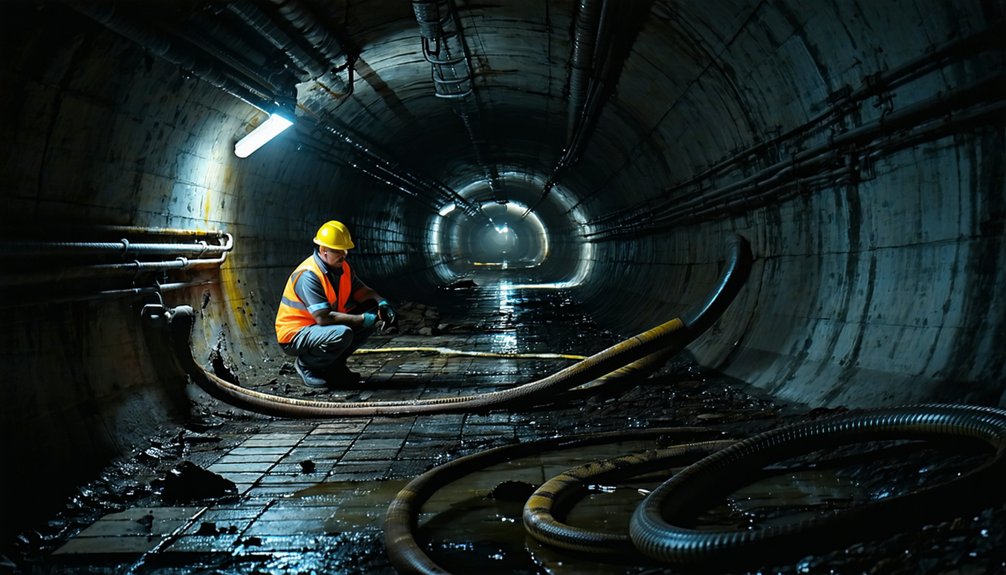Homeowners should prioritize specific inquiries when selecting sewer line repair services. Key questions include the technician's experience and qualifications in handling various sewer materials. Understanding the diagnostic methods employed, such as video inspections and smoke testing, is essential for identifying issues accurately. It's also important to request detailed estimates that break down costs, along with warranty information that outlines coverage and conditions. Such considerations enhance decision-making and guarantee effective repairs. More details on this important process are available.
What Experience and Qualifications Do You Have in Sewer Line Repair?
When evaluating a plumber's experience and qualifications in sewer line repair, it is essential to contemplate several key factors. A reputable plumbing company should be licensed, bonded, and insured, confirming adherence to industry standards. It is important to inquire about the plumber's specific experience with various sewer line materials, such as PVC, cast iron, and clay, as this knowledge directly impacts the effectiveness of repair services. References from prior clients can provide insight into the plumber's work ethic and client satisfaction regarding sewer line repair. Additionally, familiarity with complex issues like tree root invasions and collapsed sewer lines is indicative of a professional plumber's problem-solving abilities. Proficiency with specialized techniques, such as hydro jetting and video inspection, is also significant, ensuring that the plumbing service can address intricate sewer line challenges efficiently and effectively.
What Diagnostic Methods and Technologies Do You Use?
How do plumbing professionals guarantee accurate diagnoses of sewer line issues? They employ a range of advanced diagnostic methods to ascertain precise identification of problems. Video inspections utilize waterproof cameras for a detailed visual assessment of the interior condition of sewer lines, effectively revealing cracks and blockages. Smoke testing introduces non-toxic smoke to detect leaks and cracks, highlighting areas of concern in the sewer system. Dye testing employs colored dye to trace leaks, confirming the integrity of connections and facilitating the pinpointing of specific problem areas. Hydrostatic pressure testing evaluates the system's ability to maintain pressure, ascertaining all leaks are detected. Additionally, acoustic inspection techniques leverage specialized equipment to listen for leaks and blockages, providing a non-invasive diagnostic option. Collectively, these professional services enhance the ability to identify issues accurately, paving the way for effective repair methods tailored to the unique needs of the sewer system.
Can You Provide a Detailed Estimate and Warranty Information?
Understanding the intricacies of sewer line repair costs and warranty provisions is vital for homeowners seeking reliable plumbing services. A detailed estimate should encompass all anticipated costs, including labor, materials, and potential additional charges. Requesting a breakdown of the estimate allows homeowners to understand how each component contributes to the total cost, facilitating better budget management.
Homeowners should also inquire about warranty information, which should specify the duration of coverage and the aspects of workmanship and materials included. This provides significant protection against future issues. Additionally, it is important to ask about the terms and conditions of the warranty, particularly any requirements for maintenance or inspections to guarantee its validity.
- Detailed estimates encompass labor and materials
- Breakdown aids in understanding total costs
- Warranty covers workmanship and materials
- Terms may include maintenance stipulations
- Inspections may be required for warranty retention
Frequently Asked Questions
How Do You Fix a Damaged Sewer Line?
To fix a damaged sewer line, professionals typically employ trenchless technology as a preferred repair method. This involves advanced plumbing techniques like pipe lining or bursting, which minimize disruption. Initial assessments using camera inspections identify issues such as root intrusion or blockages. Following diagnostics, repairs can be executed efficiently, with cost estimates often lower than traditional pipe replacement. Regular maintenance tips can aid in preventing future issues, enhancing system longevity and performance.
Does Insurance Cover Sewer Line Repair?
The question of whether insurance covers sewer line repair hinges on homeowners insurance policy specifics. Many policies impose coverage limits and service exclusions, often covering only damage from specific perils. Homeowners should scrutinize their policies to understand deductible amounts and the claim process. Additional endorsements may be necessary for thorough liability coverage. Given the significant repair costs associated with sewer line issues, understanding these factors is essential for adequate financial protection and emergency services.
How Do You Inspect a Sewer Line?
The subtle art of sewer line inspection encompasses various methods to uncover the hidden truths within the pipes. Utilizing camera inspection technology, professionals can identify signs of damage while highlighting the importance of maintenance. Common inspection tools include smoke, dye, and hydrostatic pressure tests, each serving as preventative measures. While DIY inspection tips may offer initial insights, professional inspection services guarantee thorough evaluations, with frequency determined by the potential costs of neglecting sewer health.
How Long Does It Take to Fix a Main Sewer Line?
The repair timeline for a main sewer line can vary considerably, influenced by factors such as service duration, repair techniques, and soil conditions. Simple blockages may require only 1 to 3 hours, while complex issues might extend to several days. Project efficiency relies on contractor availability and equipment used. Emergency repairs, guided by service quality, may also alter customer expectations, necessitating thorough inspections post-repair to guarantee integrity and functionality.



